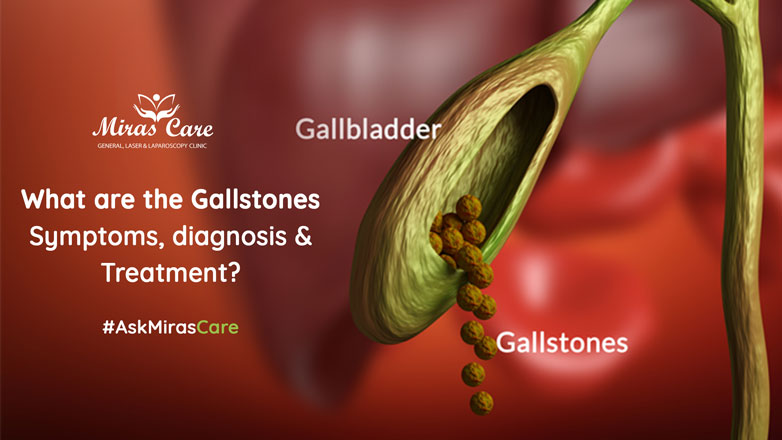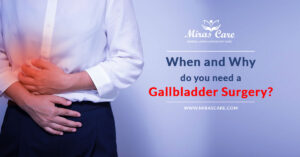The digestive system comprises of a certain set of organs and chemicals that secrete enzymes to carry out the entire process. GallBladder Symptoms is such an organ that stores a chemical called bile juice. During the process of digestion, the gall bladder contracts and empties it into the small intestine. Bile juice helps with the digestion of fat present in the consumed food.

Gallstones, also known as Cholelithiasis in the medical world, are hardened deposits of bile present in the gall bladder. This happens mainly due to two reasons – either the gall bladder cannot get emptied properly or there is too much cholesterol in the bile juice. This is a disease that needs to be detected and be dealt with as soon as possible.
What are the Causes?
Stones in the gall bladder can form when there is a chemical imbalance. This happens when the chemicals -calcium carbonate, bilirubin, and cholesterol – are present in disproportionate amounts. Medical experts have not been able to single out a cause as to why some people develop gallstones when this chemical imbalance occurs while others do not. However, it has been seen that gallstones Symptoms are more common in people with obesity.
There are two categories of gallstones, mainly:
- Cholesterol Gallstones: It occurs when the cholesterol content in the bile exceeds maximum capacity.
- Pigment gallstones: It occurs when the bilirubin content of bile exceeds a certain level. This mostly occurs in people who suffer from liver issues, infested bile tubes, and blood disorders.
The presence of stones in the gall bladder can block the pathway of digestive juices flowing to the pancreas. This can, in turn, cause jaundice or acute pancreatitis which would just add on to the suffering and pain of the patient.
Gallstones Symptoms are very common today, owing to our food habits. All of us should be careful to not be a victim of this disease. However, some people are more likely to suffer from gallstones than others, as has been reported by medical professionals.
Women who have been pregnant or are taking oral contraceptives or undergoing high dose estrogen therapies are more susceptible to gallstones. Family history and genetics, too, play a key role in determining if you can be affected by this disease. Losing weight rapidly and regaining may also increase your chances of falling prey to this disease. People taking cholesterol-lowering drugs or women undergoing Hormone Replacement Therapy during menopause are also prone. Going through a lot of stress might also lead to the development of stones in the gallbladder.
What are the Symptoms?
Medical experts have determined a few symptoms that might suggest the presence of stones in the gall bladder. Some of them are as follows:
- Infection: This can be determined by fever and shivering as the gall bladder gets infected. Usually, this leads to surgical removal of the stone or stones.
- Jaundice: When the stones block the bile duct, the bile juice cannot pass into the intestines and thus seep into the bloodstream. This causes the person with the condition to show symptoms of jaundice. The stones may pass into the intestines but if not, then they are surgically removed.
- Biliary Colic: When the stone gets stuck in the opening of the gall bladder, it might cause pain during the contraction. This causes immense pain in the abdominal region of the patient. This is called biliary colic.
- Pancreatitis: It develops when a stone blocks the pancreatic duct. This leads to liquid reflux in the duct, thus causing pancreatitis.
Other Symptoms of Gallstones have been Identified Below:
- A feeling of nausea and frequent vomiting.
- Restlessness and sweating.
- Clay-colored stools and/or dark urine.
It is best advised that whenever you face the aforementioned symptoms, you get yourself checked. Doctors, more often than not, find gallstones while testing or treating for some other medical condition. The presence of stones in the gall bladder can be detected by testing for cholesterol, ultrasound, blood test, or during X-rays. Gallstones vary in size and quantity. This, at times, makes it difficult for them to be detected as they do not show any symptoms.
What are the Treatment options?
Usually, when gallstones Symptoms occur, they need to be surgically removed by a medical professional after thorough medical analysis. This occurs only when the stones have caused inflammation in the gall bladder or have blocked the ducts or have displaced the tubes in the intestine. Following are some of the medical processes by which gallstones can be treated:
- Cholecystectomy: This process involves removing the gallbladder surgically. This can be performed in two ways – keyhole surgery or open surgery. Open surgery is more common, especially when the inflammation is quite severe. There are cases where even after cholecystectomy, the stones come back after a certain period. To prevent this, the patients are given doses of Ursodeoxycholic acid. It lowers the concentration of cholesterol in bile, thus reducing the chances of reformation of stones. However, gallstones can also be treated without surgery.
- Endoscopic retrograde Cholangiopancreatography: If for some reason, cholecystectomy cannot be performed, this method helps. An endoscope travels to the gall bladder and an electrical wire helps to widen the bile duct opening. This allows for the stones to be removed or to pass into the intestine.
- Lithotripsy: Ultrasonic waves break the stones present in the gall bladder down to small pieces that can hence, allow them to pass into the intestines and get removed by excretion. This method is used only when there are a few numbers of stones present in the gall bladder.
After the surgical removal of the gall bladder, the liver becomes responsible for the production of bile juice. It is not that a person cannot live without his or her gallbladder Symptoms but some discomforts may arise when it comes to excretion. This occurs because the bile juice, after removal of the gall bladder, flows into the small intestine more frequently. Maintaining a balanced diet, eating a lot of fruits and vegetables, and drinking lots of water can help reduce the chances of formation of gallstones.


